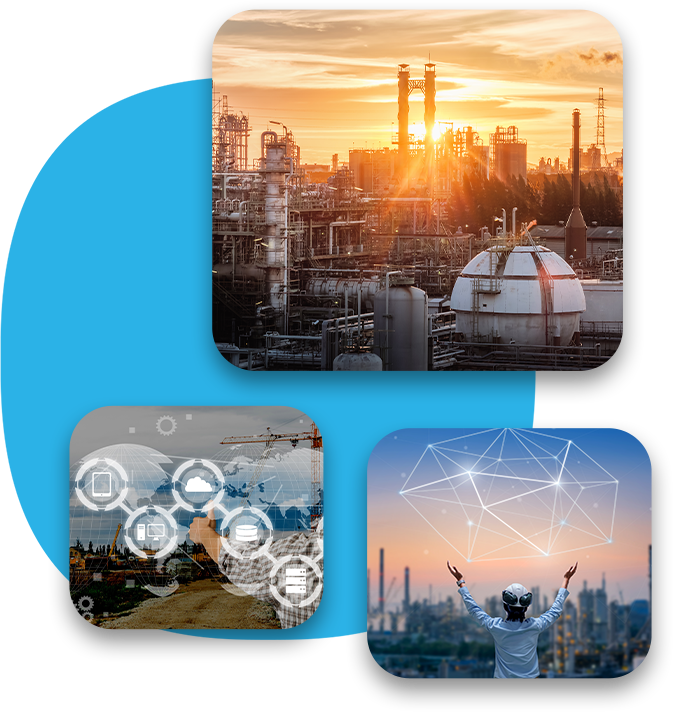
There are many Big Data and AI use-case applications in the oil and gas industry. While companies generate large amounts of data pertaining to seismic exploration, micro-seismic data, reservoir attributes, drilling time, average recovery rates, production pump performance, logistics & asset management, etc., many fail to make the most of data collected.
Instead of keeping data in separate systems and/or siloed within different geographies and/or business lines, oil & gas companies can leverage Big Data capabilities by integrating internal systems, external ecosystems, and human activity to increase operational efficiency, enhance subsurface evaluation to improve the accuracy of pre-drill resource estimates and reduce asset maintenance and maintenance costs.
Oil & gas companies can optimize oil recovery rates, optimize production and evaluate new opportunities by forecasting future performance from available historical data. They gain valuable insights in the interpretation of seismic data and reservoir models, improve asset maintenance and reduce downtime by integrating multiple data sources and ingest collected
data to analyze, visualize and share insights across business departments.
Key Big Data Analytics use cases in the oil and gas industry include:
•Surface Analysis/Geological assessment
•Well/Equipment Downtime reduction
•Production & Schedule optimization
•Asset Tracking and Maintenance using Digital Twins
•Fault/Error Detection
•Workplace Safety
•Analytics-Driven Decision Making
•Emission Tracking
•Procurement & Logistics optimization
•Inventory Management
•Administrative Process Optimization

In the upstream field, oil and gas companies may use digital rock physics to model and predict the best injection method for maximum recovery under different conditions, propose solutions to optimize crude oil production or look for new resources to guarantee continuity in the supply of crude oil.
In the downstream field, planning and scheduling systems, process unit optimization and preventive equipment maintenance may be relevant areas that can benefit from Big Data/AI analytics to assess multiple crude oil production scenario costs/benefit analysis and predict crude oil properties. Oil & gas companies may also monitor potentially fatal on-field signs, such as hazardous gas levels and unauthorized personnel entry.
Oil and gas companies may greatly benefit from the analysis of large structured and unstructured data in Continuous Catalytic Reforming (CCR), Fluid Catalytic Cracking (FCC) and
Ethylene Cracking in the oil refinery and chemical units process, using methods such as correlation analysis, single index detection, multidimensional data anomaly detection, single or multi-objective parameter optimization, and forecast analysis based on material properties.
In addition, the development of a digital twin, a real-time digital replica of a physical object or process helps oil & gas producers to manage product quality changes under different crude oil blending schemes and operating conditions, which can be simulated to adjust real production to maximize production efficiency while meeting demand.
Vital equipment such as storage tanks, pipelines, wellheads, rigs, facilities, and platforms are connected with smart sensors and data transmitters, which oil & gas companies can use to build a real-time equipment health monitoring and early warning system. By using sensors connected to the cloud, companies may monitor pumps’ variable speed motors, identify, and immediately address production issues.

By integrating the use of IoT with deep machine learning models, companies are able to monitor field operations and optimize production efficiency, uptime, equipment location & utilization, as well as maintenance planning to maintain their healthy status for a prolonged long period of time. It provides an effective means to predict equipment lifetime while reducing unplanned downtime such as shaft displacement, shaft fracture, shell cracking, power overload, etc.
It also allows for effective delivery fleet management, tracking vehicle performance, fuel inventories, and fuel usage in delivery fleets. Oil & gas companies can use digital category management, smart replenishment, and shipping transparency to improve supplier relationships and optimize logistics and warehousing.
Finally, AI chatbots can generate real-time alerts and insights into operations and processes to respond to field potentially threatening and unsafe conditions or emergencies, send automated permits to work to dispatch resources on an as-needed basis and monitor field operations remotely.
OREDATA brings under one roof infrastructure modernization, data-based project applications, as well as managed services . Using cloud computing, AI and Big Data Analytics, our unique value proposition enables us to provide end-to-end IT consultancy and implementation projects to improve operations and forecasting demand for oil and gas industry players worldwide.
